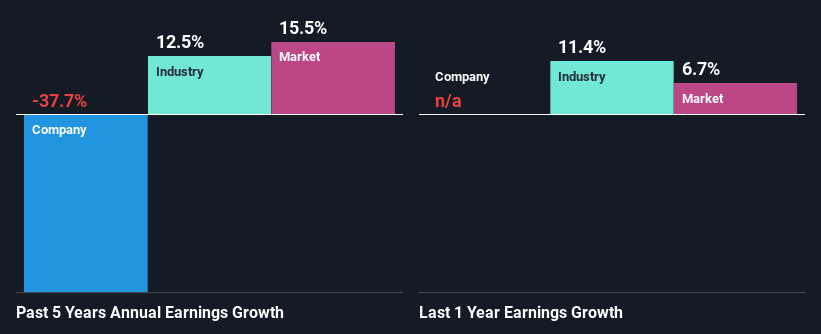- Australia
- /
- Commercial Services
- /
- ASX:DOW
Downer EDI Limited's (ASX:DOW) On An Uptrend But Financial Prospects Look Pretty Weak: Is The Stock Overpriced?

Most readers would already be aware that Downer EDI's (ASX:DOW) stock increased significantly by 17% over the past three months. However, in this article, we decided to focus on its weak fundamentals, as long-term financial performance of a business is what ultimately dictates market outcomes. In this article, we decided to focus on Downer EDI's ROE.
Return on Equity or ROE is a test of how effectively a company is growing its value and managing investors’ money. In simpler terms, it measures the profitability of a company in relation to shareholder's equity.
See our latest analysis for Downer EDI
How Is ROE Calculated?
The formula for ROE is:
Return on Equity = Net Profit (from continuing operations) ÷ Shareholders' Equity
So, based on the above formula, the ROE for Downer EDI is:
3.6% = AU$82m ÷ AU$2.3b (Based on the trailing twelve months to June 2024).
The 'return' is the yearly profit. So, this means that for every A$1 of its shareholder's investments, the company generates a profit of A$0.04.
What Is The Relationship Between ROE And Earnings Growth?
We have already established that ROE serves as an efficient profit-generating gauge for a company's future earnings. Based on how much of its profits the company chooses to reinvest or "retain", we are then able to evaluate a company's future ability to generate profits. Generally speaking, other things being equal, firms with a high return on equity and profit retention, have a higher growth rate than firms that don’t share these attributes.
Downer EDI's Earnings Growth And 3.6% ROE
It is quite clear that Downer EDI's ROE is rather low. Not just that, even compared to the industry average of 9.5%, the company's ROE is entirely unremarkable. Given the circumstances, the significant decline in net income by 38% seen by Downer EDI over the last five years is not surprising. We believe that there also might be other aspects that are negatively influencing the company's earnings prospects. For example, the business has allocated capital poorly, or that the company has a very high payout ratio.
However, when we compared Downer EDI's growth with the industry we found that while the company's earnings have been shrinking, the industry has seen an earnings growth of 12% in the same period. This is quite worrisome.

Earnings growth is an important metric to consider when valuing a stock. What investors need to determine next is if the expected earnings growth, or the lack of it, is already built into the share price. By doing so, they will have an idea if the stock is headed into clear blue waters or if swampy waters await. If you're wondering about Downer EDI's's valuation, check out this gauge of its price-to-earnings ratio, as compared to its industry.
Is Downer EDI Using Its Retained Earnings Effectively?
Downer EDI has a high three-year median payout ratio of 86% (that is, it is retaining 14% of its profits). This suggests that the company is paying most of its profits as dividends to its shareholders. This goes some way in explaining why its earnings have been shrinking. With only very little left to reinvest into the business, growth in earnings is far from likely. Our risks dashboard should have the 2 risks we have identified for Downer EDI.
Moreover, Downer EDI has been paying dividends for at least ten years or more suggesting that management must have perceived that the shareholders prefer dividends over earnings growth. Upon studying the latest analysts' consensus data, we found that the company's future payout ratio is expected to drop to 62% over the next three years. As a result, the expected drop in Downer EDI's payout ratio explains the anticipated rise in the company's future ROE to 13%, over the same period.
Conclusion
Overall, we would be extremely cautious before making any decision on Downer EDI. Because the company is not reinvesting much into the business, and given the low ROE, it's not surprising to see the lack or absence of growth in its earnings. That being so, the latest industry analyst forecasts show that the analysts are expecting to see a huge improvement in the company's earnings growth rate. To know more about the latest analysts predictions for the company, check out this visualization of analyst forecasts for the company.
New: Manage All Your Stock Portfolios in One Place
We've created the ultimate portfolio companion for stock investors, and it's free.
• Connect an unlimited number of Portfolios and see your total in one currency
• Be alerted to new Warning Signs or Risks via email or mobile
• Track the Fair Value of your stocks
Have feedback on this article? Concerned about the content? Get in touch with us directly. Alternatively, email editorial-team (at) simplywallst.com.
This article by Simply Wall St is general in nature. We provide commentary based on historical data and analyst forecasts only using an unbiased methodology and our articles are not intended to be financial advice. It does not constitute a recommendation to buy or sell any stock, and does not take account of your objectives, or your financial situation. We aim to bring you long-term focused analysis driven by fundamental data. Note that our analysis may not factor in the latest price-sensitive company announcements or qualitative material. Simply Wall St has no position in any stocks mentioned.
About ASX:DOW
Downer EDI
Operates as an integrated facilities management services provider in Australia and New Zealand.
Excellent balance sheet with moderate growth potential.
Similar Companies
Market Insights
Community Narratives




